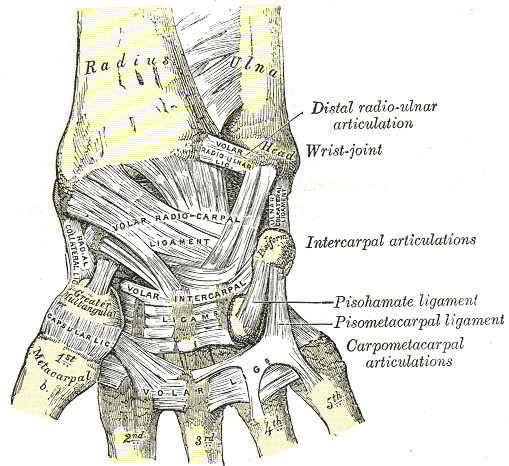Wrists intimidate the be-Jesus out of me. They're an unbelievably complex joint - an area where so many small moving parts converge into one tiny space. Not only that, but as percussionists wrists receive an overwhelming amount of attention, so there's a certain gravity to any information presented on them. Hence why the wrist is a multi-part series of posts.
There's much to say and even more to learn about this joint, but I thought that perhaps one of the most useful ways to begin would be to view some diagrams. Perhaps in viewing the joint from the many layers on the inside, we can rethink how we perceive its movement on the outside.
From the Inside, Out
Skeletal Structure
Just like other joints, the wrist is not a bone but a place of movement. The diagram below shows the right arm if you turn your palm towards you, bend the elbow, and move your forearm in front of your body. The wrist occurs in the space between the ends of the radius and ulna and the many small carpals just past them.
There will be a future post focusing on the skeletal structure of the wrist.
Tendons and Ligaments
Ligaments attach bone to bone. The drawing below shows ligaments on the palm-side of the wrist; here, for a right hand.
Ligaments viewed from the back of the right hand:
A future post will focus on the ligaments.
Tendons attach muscle to bone. When you consider the many ways wrists and hands move, the incredible number of tendons in this area is not surprise. Staying with the right hand:
Here's a reminder of the tendons coming from the forearm:
Yep. More on that later, too.
Muscles
Three layers of muscle, for the right forearm, palm up.
You guessed it: more on this in a future post, too.
Right forearm, posterior view:
Common Injuries
Though I'm a big believer that pain in a small joint means misuse of a larger joint and/or muscles, there are certain injuries whose symptoms affect the wrist in an isolated way.
First, there's Carpal Tunnel. If you feel pain or numbness on the thumb side of your hand, you may be dealing with this. Many things can cause compression of the median nerve, but a common thought is that smaller wrists have less room for tendons to move, so the nerve is compressed as a result.
More than one person I know has dealt with a ganglion (yeah, new word for me, too). They are attached to deep tissues, and are a swelling of joint fluid. Yikes.
Another injury (and new-to-me term) is de Quervain's tenosynovitis. To us, we call it "that sharp pain at the bottom of my thumb that doesn't go away when I stretch it." For more information on these and other injuries, check out
this website.
Explanations and explorations of injuries will pervade each future post.
To Conclude
If you're a fan of the Marimba Body series, would you mind giving me a shout in the comments? I'd love to know if these posts are useful to others out there, and if you all research these topics too. :)
Next post: Skeletal Anatomy of the Wrist.











please keep going with this. I've had wrist injuries in the past and want to know a better way to prevent further injuries :)
ReplyDeleteWill do! Thanks for reading :)
DeleteFascinating! Thank you for posting. I am sharing this with my saxophone students.
ReplyDeleteAwesome. Hopefully it will keep them from injury!
DeleteThis is a very informative introduction to wrist anatomy.
ReplyDelete